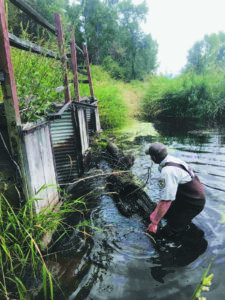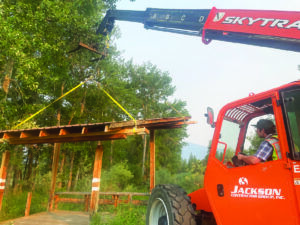
by Michael Howell
A project to restore fish passage and streamside habitat at the mouth of North Burnt Fork Creek as it passes through Lee Metcalf National Wildlife Refuge is under way. It’s been a long time coming. The project was first envisioned as part of the Refuge Comprehensive Conservation Plan Goals for the Bitterroot River Floodplain and North Burnt Fork Creek back in 2012. A Draft Environmental Assessment was produced in November of 2022. The project, led by Lee Metcalf National Wildlife Refuge, Trout Unlimited and Montana Fish, Wildlife and Parks, will help reconnect the lower portion of North Burnt Fork Creek to its historical channel alignment, restoring riverine habitat to a portion of the creek that has been impounded and managed as wetland habitat for many years and eliminate a barrier culvert that has prevented fish from moving between the Bitterroot River and North Burnt Fork Creek for over 50 years. The project will open up 2.5 miles of North Burnt Fork Creek habitat to Bitterroot River fish, improving the overall health of the fishery and recreation opportunities.
The current barrier structure – a set of two vertical pipes leading into two culverts – was historically used to impound and divert water for waterfowl habitat. It effectively impounds water but also created a full passage barrier to fish migrating between the Bitterroot River and North Burnt Fork Creek. Many fish species in the Bitterroot, including federally listed threatened bull trout and a Montana Species of Special Concern, Westslope Cutthroat trout, migrate into tributaries like North Burnt Fork Creek to spawn. The structure has encouraged sediment to precipitate out, which, over time, has made this area less beneficial for waterfowl. The project will place a new, larger, bottomless culvert to maintain public access throughout the trail system while also opening fish passage.
According to the Environmental Assessment, the reason for selecting a bridged culvert over a spanned bridge is that it is cost effective and will also allow heavy equipment and emergency vehicles to pass over the creek, eliminating the need for, and disturbance of, creating an upstream low-water crossing. Eliminating the low water crossing also precludes the need to haul approximately 813 cubic yards of material off site from sloping the creek’s levees.
Where North Burnt Fork Creek meets the water control structure, a smaller, ditched channel diverts a portion of water northwards. The channel is dry each summer. Under this action, this northward channel will be maintained for high flow events, but recontoured from its current, linear ditch form into a series of wetland swales.
According to Bitterroot Trout Unlimited Project Manager Christine Brissette, plans also include a major effort to improve streamside riparian habitat for shade and cover. Reed canary grass, a highly aggressive non-native grass, has established throughout the riparian area, outcompeting the native trees and shrubs and simplifying habitat for migratory songbirds, amphibians, and other riparian-dependent wildlife. Heavy equipment will remove reed canary grass sod, and volunteer crews will follow with plants, weed mat and fencing.
Brissette said that the restoration, although significant, is not intended to fully eradicate reed canary grass from the property. “Given its aggressive root system and ability to recolonize, this is not a reasonable expectation,” she said. Instead, it will establish a native tree and shrub component alongside reed canary grass, providing shade, bank stability and cover. Over time, mature cottonwoods are known to shade out reed canary grass, further limiting its impact on habitat. Besides cooling off the water, the native trees and shrubs will also provide more varied habitat for the waterfowl and songbirds.
The 2,800-acre Refuge was established on February 4, 1964 and is managed by U.S. Fish and Wildlife Service (USFWS) for the protection of migratory bird species. and is primarily managed for wildfowl and migrating songbird habitat.
According to Refuge Manager Tom Reed, the Refuge provides a diverse mosaic of western mountain valley habitats including gallery and riverfront forest, wet meadow, wetlands, and grassland benches. The Refuge also provides opportunities for the public to enjoy compatible wildlife-dependent recreation, including hunting, fishing, wildlife observation, photography, environmental education, and interpretation. It is a very popular community and tourist destination with more than 143,000 visitors annually. The fish barrier being replaced sits below the popular Metcalf Trail in the Wildlife Viewing Area, used by many for walking, wildlife viewing, and environmental education and interpretation.
“This is a project that was on the books for a long time now but because of the size of our staff and funding we probably wouldn’t have gotten to it,” said Reed. “Because of where it’s at we did an EA, a Section Seven, a Cultural Resource Report, all as part of the permitting process, so it’s taken way longer than we expected. So, it’s really been positive to be working with Christine and Trout Unlimited to be able to move forward at the rate that we are now.”
Reed said that the culvert barrier is for a bona fide water right on North Burnt Fork Creek that diverts water northerly and runs north past the golf course located on the Refuge before returning to the Bitterroot River. He said they aim to keep the water right but hope to convert it to an instream right.
“We don’t want to lose the water right, but we want it to work better for fish and wildlife than what it has been doing,” said Reed.
According to Reed, they have been spraying the area for yellow flag iris, another non-native invasive plant, in preparation for the work on removing the reed canary grass along the banks of the creek.

Timberland Excavating will be the lead contractor on the project, with oversight from River Design Group and Trout Unlimited. Great Bear Native Plants of Hamilton will supply native trees and shrubs. Volunteers from Jackson Contractor Group and Bitterroot Trout Unlimited have been instrumental in preparing for work, as has the City of Missoula and Missoula County who are supplying brush for streambank construction.
According to Dave Ward, President of the Bitterroot Chapter of Trout Unlimited, although they haven’t gotten official approval from the City of Hamilton, he is pretty confident that the City Council will approve taking about 1,000 willow cuttings from an area in Skalkaho River Park to use in the project. He said they are not uprooting any willows in the park and the area should successfully regrow within a year.
His organization will be working together with volunteers from the Trapper Creek Job Corps on building the “exclusion areas” to protect the revegetated area. They have also enlisted the help of student volunteers from the Classrooms Without Walls programs in Hamilton and Corvallis. In total, this effort will plant, fence, and weed mat 300+ trees and shrubs and plant 3,000+ willow cuttings along the banks and floodplain of half a mile of North Burnt Fork Creek.
The project was made possible through funding from the U.S. Fish and Wildlife Service, Montana Department of Natural Resources and Conservation, Bitterroot Chapter of Trout Unlimited, Westslope Chapter of Trout Unlimited, Steele-Reese Foundation, Farmers State Bank (Victor Branch), and numerous private donors who came together to meet this need.
During construction, several measures will be in place to ensure that in-stream impacts from construction are minimal and temporary. In-stream work will only occur during a window of time that bull trout and other salmonids are least sensitive to in-stream disturbance. Additionally, temporary cofferdams and pumps will be constructed at the culvert/stoplog location to provide localized dewatering during removal and bridged culvert placement. Suspended sediment, stormwater and erosion control structures (e.g., silt fence and silt curtain) will also be in place to limit sediment impacts to the immediate construction area.
Visitor access along the trail system may be limited during construction in September and October. Whenever possible the north trail system (Ponderosa Loop) will remain open, but full closures will be necessary at times to keep visitors and equipment operators safe.
Signs at the Wildlife Viewing Area parking lot will keep visitors up to date on project progress, trail closures and volunteer opportunities. For questions, contact Refuge Headquarters at 406-777-5552.